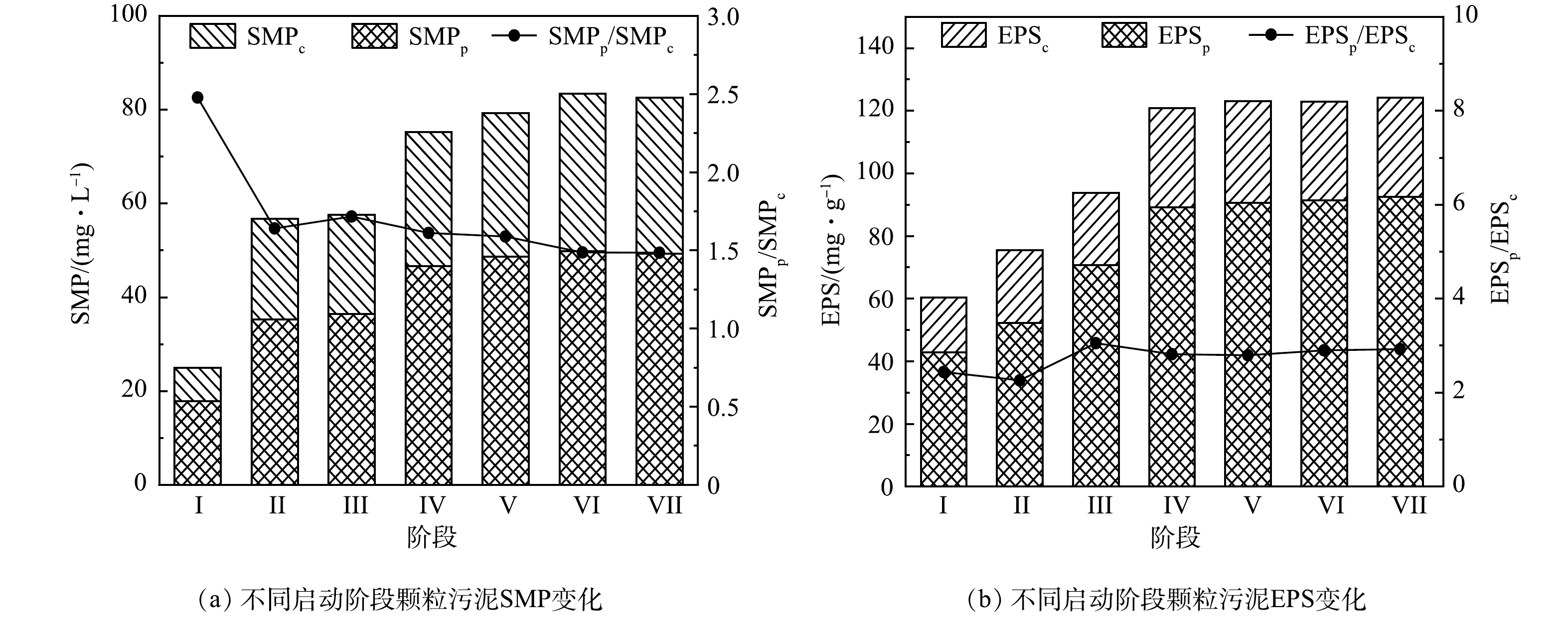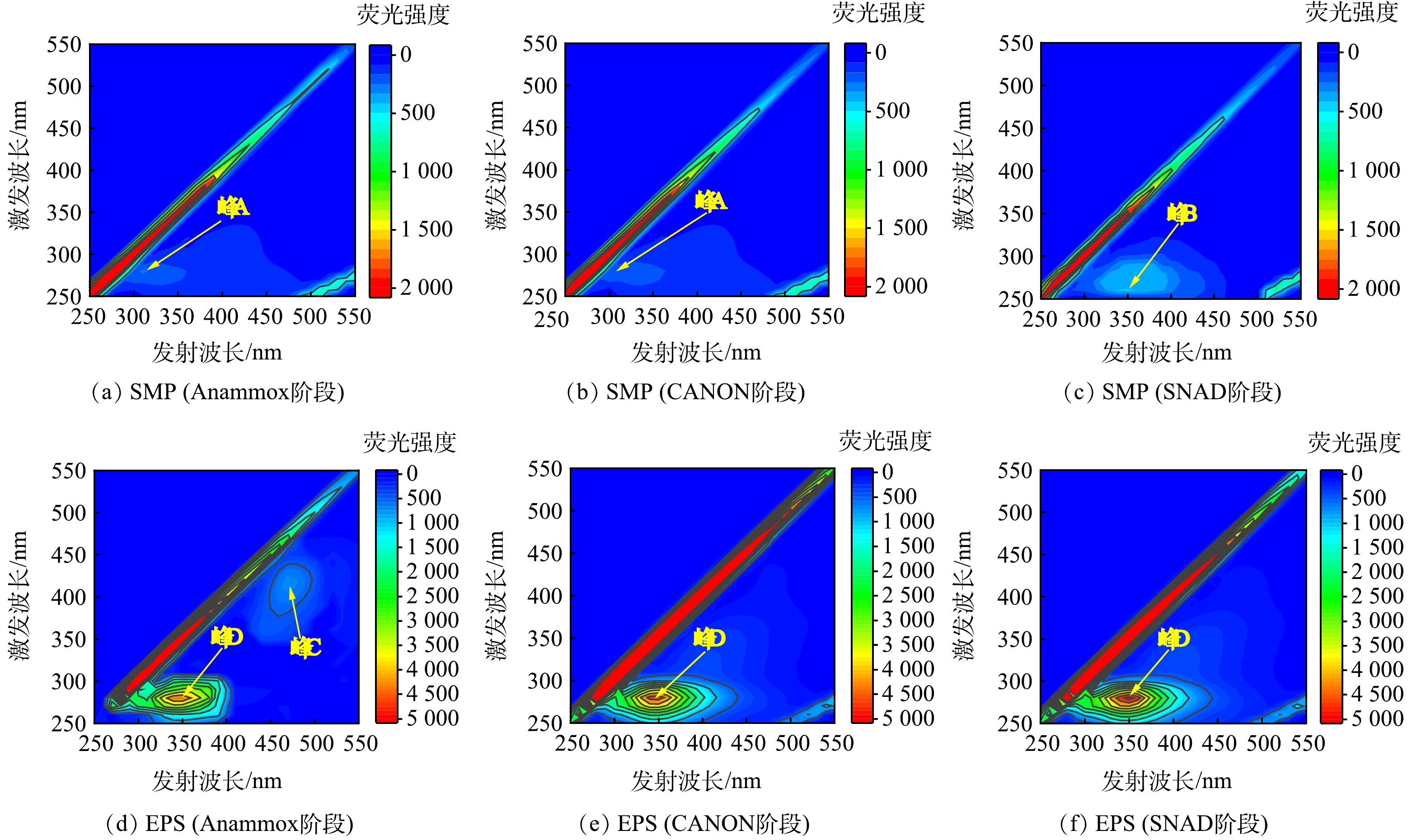-
随着工业发展和人民生活水平提高,由氮素过量排放引起的水体富营养化成为一个亟待解决的问题,而传统硝化-反硝化生物脱氮工艺呈现出能耗大、需外加碳源及污泥产量高等不可持续特点。厌氧氨氧化(Anammox)工艺以其经济、高效等特点在生物脱氮领域备受关注,该技术主要是依靠一类浮霉菌门的自养厌氧氨氧化菌(AnAOB)以NH4+-N和NO2−-N为底物反应生成N2的过程,理论总氮(total nitrogen,TN)去除率可达90%左右[1]。然而,Anammox工艺尾水中仍有近10%的氮素以NO3−-N形式存在。为了进一步提高Anammox工艺运行效能,同步厌氧氨氧化耦合异养反硝化(simultaneous anammox and denitrification,SAD)、同步亚硝化、厌氧氨氧化耦合异养反硝化(simultaneous partial nitrification, anammox and denitrification,SNAD)等工艺技术层出不穷[2-4]。而对于主流城市污水而言,进水氮素主要以氨氮形式存在,因此SNAD工艺适用性更强,该技术主要依靠好氧氨氧化菌(AerAOB)、AnAOB协调作用实现Anammox反应,并通过引入反硝化菌(Denitrifying bacteria,DNB)进一步削减NO3−-N实现脱氮除碳的工艺过程。
值得注意的是,AnAOB生长周期较长且易于流失,是Anammox工艺启动的技术瓶颈,从而直接影响SNAD工艺启动过程。颗粒污泥是一种固定化微生物聚合体,具有密实的结构和良好的沉降性能,可以实现AnAOB的有效持留[5]。范丹等[6]在序批式反应器(sequencing batch reactor,SBR)中以1.1 mm的Anammox颗粒污泥成功启动SNAD工艺,启动时间为37 d。此外,为了强化AnAOB富集以加速颗粒污泥形成,膜生物反应器(membrane bioreactor,MBR)可以作为Anammox及SNAD颗粒污泥工艺启动的有效方式[7]。LIU等[8]采用MBR强化AnAOB富集并成功加速颗粒污泥的形成(平均颗粒粒径为0.7 mm)。张肖静等[9]采用MBR经过100 d成功启动SNAD颗粒污泥工艺,TN去除率可达98%。与传统MBR工艺类似,SNAD-MBR工艺启动过程中也不可避免地会出现膜污染问题,而颗粒污泥性质会直接影响膜污染行为特性。ZHUO等[10]发现在Anammox颗粒污泥体系中紧密结合型胞外聚合物(tightly bound-EPS,TB-EPS)含量以及EPS中腐殖质含量与膜污染速率之间有较好的相关性。LI等[7]研究表明随着Anammox颗粒中小粒径组分减少及平均粒径增大,膜污染得到显著缓解。XING等[11]认为Anammox颗粒污泥体系中溶解性微生物产物(soluble microbial products,SMP)中的蛋白质组分是造成膜污染的主要因素,而郭佳[12]研究结果表明EPS是SNAD-MBR工艺膜污染的关键因子。
可见,在以往的研究中对于Anammox-MBR及其系列工艺中膜污染关键因子尚无统一认识;此外,由于SNAD工艺启动过程复杂性,SNAD-MBR工艺的颗粒污泥特性与膜污染行为的动态变化及其两者之间的
相关性尚不明晰,且针对此工艺的膜污染预测模型鲜有报道。本研究在系统分析SNAD-MBR工艺启动过程中颗粒污泥特性动态变化的基础上,探究其与膜污染速率之间的相关性,通过统计学手段识别膜行为的关键因子并建立膜污染预测模型,以期为SNAD-MBR工艺的优化运行及推广应用提供理论基础与技术支持。
-
本实验采用升流式微氧污泥床膜生物反应器(upflow micro-oxygen sludge bed membrane bioreactor,UMSB)装置,其工艺流程如图1所示。反应器和水箱采用有机玻璃制成,有效容积为4.5 L。反应器内装有一组中空纤维膜组件(polyvinylidene fluoride,PDVF),膜孔径为0.3 μm,有效过滤面积为0.075 m2。膜组件采用间歇出水(产水8 min,停止2 min),通量根据水力停留时间需求进行调整(3.13~14.81 L·(m2·h)−1),并通过压力表监测跨膜压差(transmembrane pressure,TMP)变化。反应器设有内循环,回流比控制在32.0~49.0。反应器底部装有微孔曝气头,通过人工调整曝气量以保证溶解氧(dissolved oxygen,DO)浓度维持在0.3~0.8 mg·L−1,并通过pH-DO传感器(WTW Multi3630,德国)监测反应器的pH和DO浓度。采用循环水浴系统控制反应器温度维持在(30±2) ℃,整个启动过程不进行排泥操作。
-
SNAD工艺启动过程中Anammox阶段接种AnAOB污泥(自本实验室稳定运行的Anammox-UASB反应器),接种量为1 L,污泥质量浓度(mixed liquor suspended solids,MLSS)为3568 mg·L−1,MLVSS/MLSS比为0.48;在CANON阶段向反应器中补充接种AerAOB污泥(自北方某城市污水处理厂氧化沟工艺),接种量为0.5 L,MLSS质量浓度为3682 mg·L−1,MLSS/MLVSS比为0.73。
-
SNAD工艺启动共历经Anammox、CANON和SNAD 3个阶段。Anammox阶段(Ⅰ~Ⅲ)共运行28 d,通过逐步缩短水力停留时间(hydraulic retention time,HRT)恢复强化富集AnAOB;CANON阶段(Ⅳ~Ⅵ)共49 d,采用间歇曝气,维持DO在0.3~0.8 mg·L−1左右,阶段Ⅳ采用间歇运行(换水比为22%,反应时间由33 h缩短至11 h,排水1.1 h,进水和排水时停止内循环),Ⅴ~Ⅵ阶段采用连续进水,保持HRT为10 h;SNAD阶段(Ⅶ)共运行21 d,HRT为10 h,在间歇曝气下投加适量碳源(乙酸钠),C/N比为1:0.5;各阶段进水均为人工模拟废水,具体运行条由表1所示。
-
1)水质及污泥性质分析。COD、NH4+-N、NO2−-N、NO3−-N、MLSS和MLVSS均按《水和废水监测分析方法》(第4版)进行测定[13]。采用污泥容积指数(sludge volume index,SVI)测定污泥的沉降性性能;污泥粒径分布采用筛分法,从反应器中取出颗粒污泥并用去离子水清洗3次以上,利用标准检验筛进行筛分,分为1.0<、1.0~1.5、1.5~2.0、2.0~2.5、>2.5 mm,根据均值权重分析法计算得到平均粒径(particle size diameter,PSD)[14]。溶解性微生物产物(SMP)和胞外聚合物(EPS)采用热处理法萃取,其中SMP和EPS的蛋白质组分(简称为SMPp和EPSp)含量采用考马斯亮蓝法测定,SMP和EPS的多糖组分(简称为SMPc和EPSc)含量采用苯酚-硫酸法测定[15]。
2)膜污染速率计算。SNAD-MBR工艺启动过程中的膜渗透性和膜污染速率根据式(1)和式(2)进行计算。
式中:L为膜渗透性,L·(m2·h·kPa)−1;J为膜通量,L·(m2·h)−1;ΔPTMP为跨膜压差,kPa;Fr为膜污染速率,L·(m2·h2·Pa)−1;Δt为各阶段运行时间,h。
3)傅里叶变换红外(fourier transform infrared spectrometer,FT-IR)光谱分析。取各阶段末期反应器中的颗粒污泥,用去离子水冲洗3次,在105 ℃下烘干后与KBr按1:150压片,采用傅里叶变换红外光谱仪(IRAffinity-1S,日本岛津公司)进行测定,结果数据均采用Origin 8.0进行处理与分析。利用傅里叶自去卷积法对红外光谱酰胺Ⅰ区(1 600~1 700 cm–1)进行处理,并利用PeakFit(V. 4.12,https://systatsoftware.com/peakfit/)计算二阶导数谱和曲线拟合[16]。
4)三维荧光光谱(Three-dimensional excitation emission matrix fluorescence spectroscopy,3D-EEM)分析。各阶段颗粒污泥萃取得到的SMP和EPS提取液,通过三维荧光光谱仪(日立F7100,日本)进行测定,激发波长(Ex) 200~550 nm,间隔10 nm;发射波长(Em) 200~550 nm,间隔10 nm,扫描速度为60 000 nm·min−1,结果数据均采用Origin 8.0进行处理与分析。
5)SPSS分析。采用SPSS软件(Statistics 17.0)对实验数据进行统计学分析,皮尔逊系数rp(-1.0~1.0)反映污泥性质参数与膜污染速率的相关性;其中,rp=1时表示完全正相关,rp=-1时表示完全负相关,rp=0则表示无相关性;本实验数据的相关性在统计学上被认为在95%置信区间内显著(即P<0.05)。
-
不同启动阶段SNAD-MBR工艺的跨膜压差(TMP)及膜通量的变化如图2所示。由于膜污染行为的发生,在Anammox、CANON及SNAD 3个阶段,TMP随反应器运行而逐步增高。反应器分别在第Ⅲ、Ⅳ、Ⅵ阶段末进行离线化学清洗,以恢复系统的膜渗透性。在Anammox、CANON及SNAD 3个阶段中,Fr由1.21 L·(m2·h2·Pa)−1降至1.08 L·(m2·h2·Pa)−1,表明系统膜污染速率呈现下降趋势。Anammox启动阶段(I~Ⅲ),虽然通过增加通量缩短HRT以强化AnAOB富集,而Fr呈现下降趋势;在CANON阶段启动初期(Ⅳ间歇运行),Fr达到了3.57 L·(m2·h2·Pa)−1,显著高于整个Anammox阶段的膜污染速率,这是由于短期高通量排水所致;而在CANON阶段启动后期(V~VI连续运行)及SNAD阶段,膜污染速率呈现减缓趋势(由1.18降至1.08 L·(m2·h2·Pa)−1),这些膜污染行为特性很有可能是由于颗粒污泥性质变化所引起。
-
1)污泥表观形态、污泥粒径、MLSS及SVI变化。SNAD-MBR工艺不同启动阶段颗粒污泥表观形态、粒径分布、MLSS与SVI变化如图3和图4所示。可以看到,从Anammox阶段到CANON阶段,颗粒由深红色转变为黄棕色,污泥粒径有所增加;在CANON阶段到SNAD阶段,颗粒由颗粒污泥颜色变浅,这主要是反硝化菌在颗粒表面增值所致。在SNAD启动过程中颗粒污泥粒径呈现增大趋势,其中Anammox阶段污泥粒径主要集中在1.5~2.0 mm,粒径>2.5 mm部分占比有所增加。而在CANON阶段,有少量活性污泥絮体的投加,间歇运行阶段时强化了AnAOB颗粒污泥对絮体污泥的吸附,为AerAOB-AnAOB颗粒的形成奠定了基础。在SNAD阶段,有机物的投加促进DNB在AerAOB-AnAOB颗粒表面的生长。可见,CANON和SNAD阶段较Anammox阶段颗粒粒径有所增加,粒径占比由1.5~2.0 mm向2.0~2.5 mm转变。与此同时,在SNAD-MBR工艺整个启动过程中,MLSS由10.7 g·L−1逐渐升高至16.7 g·L−1,SVI值则由47 mL·g−1降低至26 mL·g−1。由此可见,随着污泥粒径与MLSS的增大,污泥沉降性也不断改善。有研究[17]表明,由于颗粒污泥良好的沉降性,可以显著降低其在膜表面形成滤饼层的概率,从而可降低膜污染速率。
2) SMP与EPS的变化。SMP和EPS被视为是MBR工艺中引起膜污染行为的关键因素[18],SNAD-MBR工艺不同启动阶段的SMP和EPS含量及组成如图5所示。在Anammox阶段,SMP含量由25.0 mg·L−1增长至57.6 mg·L−1,SMPp/SMPc比由2.47骤降至1.72左右,这是由于缩短HRT增加氮负荷强化AnAOB的分泌与代谢,其中分泌物中SMPc的含量显著高于SMPp;而在CANON和SNAD阶段,间歇曝气致使反应器内DO浓度升高,并且AerAOB的引入进一步促进SMP含量由57.62 mg·L−1增长至82.7 mg·L−1,而SMPp/SMPc比进一步降低(由1.72至1.48)。EPS组成直接影响污泥表面特性,EPSp含量增加能显著提高污泥疏水性,降低污泥表面电荷,促进颗粒污泥形成[19]。在Anammox阶段,EPS含量由60.3 mg·g−1增长至93.8 mg·g−1,EPSp/EPSc比由2.44增至3.05;在CANON和SNAD阶段,EPS含量保持在122 mg·g−1左右上下波动,EPSp/EPSc比由2.81缓慢升至2.92,这与SNAD启动过程中颗粒污泥大粒径占比增加现象相吻合。
-
通过FT-IR对SNAD-MBR工艺不同启动阶段末期颗粒污泥进行了解析。如图6所示,Anammox、CANON和SNAD 3个阶段末期颗粒污泥呈现相近的的红外图谱,均在3 443 cm–1处发现较强的吸收峰[20],主要为蛋白质类和多糖类物质N—H和O—H伸缩振动引起;在2 940 cm–1处存在一个较弱的吸收峰,为脂肪类有机物中C—H反称伸缩振动造成[21];2 337 cm–1处可能由系统生成的CO2引起[22];1 654 cm–1处的强烈吸收带归因于蛋白质酰胺I的C=O和C=C拉伸振动[20];1 403 cm–1处峰值随阶段进行逐渐降低,该峰与酰胺Ⅱ区O—C—O对称拉伸有关[23];1 044 cm–1处为多糖物质的特征峰,主要与C—O—C伸展振动有关[24]。值得注意的是,虽然各个阶段颗粒污泥的红外光谱峰值位置相近,但是峰值强度存在差异。随着SNAD-MBR工艺启动过程的推进,各峰强度呈现增强趋势,表明各官能团含量不同程度增加,对颗粒污泥进一步形成发挥重要作用。
通常,蛋白质的二级结构直接影响污泥吸附和聚集性能[25]。因此,对各阶段末颗粒污泥的红外光谱酰胺Ⅰ区(1 600~1 700 cm–1)进行分析,并通过二阶导数和曲线拟合揭示蛋白质二级结构差异,分析结果如图6所示,其中4种二级结构相对含量如表2所示。一般来说,α-螺旋/(β-折叠+无规则卷曲)比值用于评价蛋白质的亲疏水性[25]。当α-螺旋/(β-折叠+无规则卷曲)比值较低时,蛋白质分子表现出较松散的结构,这导致蛋白质分子内疏水基团暴露,使得颗粒污泥蛋白质物疏水性增强[26]。在本研究中,各阶段颗粒污泥的α-螺旋/(β-折叠+无规则卷曲)比值均在较高水平(P>0.5),这与FANG等[27]研究结果类似。此外,随着SNAD-MBR工艺启动过程的推进,α-螺旋/(β-折叠+无规则卷曲)比值逐渐降低,颗粒污泥蛋白质疏水性升高,对颗粒污泥的形成具有积极影响。
-
SNAD-MBR工艺不同启动阶段末期颗粒污泥SMP和EPS的3D-EEM分析结果如图7所示。可见,SMP中存在2个特征荧光峰,峰A(Ex/Em: 280 nm/310 nm)与微生物分泌的可溶性相关物质,主要为酪氨酸;峰B(Ex/Em: 260 nm/350 nm)主要是色氨酸相关物质;EPS中存在2个特征荧光峰,峰C(Ex/Em: 420 nm/470 nm)为腐殖酸荧光峰,峰D(Ex/Em: 280 nm/350 nm)为色氨酸荧光峰。在Anammox阶段,SMP中主要为酪氨酸荧光峰,EPS中主要为色氨酸荧光峰,带有较弱的腐殖酸荧光峰;在CANON阶段,SMP中酪氨酸荧光峰强度略微增强,EPS中色氨酸荧光峰强度增强,腐殖酸荧光峰基本消失;而在SNAD阶段,SMP中酪氨酸荧光峰强度减弱,并逐渐向色氨酸荧光峰转移,EPS中色氨酸荧光峰强度持续增强。以上结果表明,在SNAD工艺启动过程中,SMP中酪氨酸荧光强度逐渐降低,后期逐渐向色氨酸荧光峰演替,色氨酸含量增加,这也可能是膜污染物质的主要组分。EPS中色氨酸类物质逐渐增加,而腐殖酸随进程逐渐被淘汰,说明色氨酸在颗粒污泥形成与稳定过程中起到重要作用。ZHU等[28]研究结果表明芳香族蛋白及色氨酸类物质在颗粒污泥形成起到重要作用,与本实验结果类似。
-
由以上结果可知,在SNAD-MBR启动过程中颗粒污泥性质指标发生不同程度地变化,而这些指标如何影响膜污染速率尚不清楚。为此,利用SPSS软件对污泥性质与膜污染速率间的相关性进行分析,具体结果由图8所示。可见,SVI和SMPp/SMPc比与膜污染速率之间呈现正相关(rp>0.7),而MLSS、EPS、SMP、EPSc、EPSp、SMPc、SMPp及EPSp/EPSc比与膜污染速率呈现负相关性(|rp|>0.4)。
1)MLSS、SVI和PSD对Fr的影响。随着启动阶段推进,MLSS质量浓度从10.7 g·L−1逐渐升至16.7 g·L−1。有研究表明,MLSS浓度增大会增加混合液的粘度,从而引起污泥在膜组件表面的附着与积累,导致过滤阻力显著增大[29]。而在本实验中,MLSS质量浓度污泥增加以粒径增加为呈现形式,小颗粒物质含量相对减少,因此Fr降低。SVI是污泥沉降性能及絮凝性能的主要指标,污泥沉降性能提高可以降低过滤阻力,提高泥水分离效率。PSD能够显著影响膜渗透性,较小的PSD提高了絮体在膜表面沉积的概率,容易形成滤饼层阻力[30]。由图8可知,MLSS质量浓度与Fr之间呈现负相关性(rp=-0.685,P>0.05),SVI值与Fr呈现较强正相关性(rp=0.781,P>0.05),PSD与Fr呈现较弱负相关性(rp=-0.214,P>0.05)。这也进一步表明随着MLSS质量浓度升高、SVI降低和PSD增大,Fr下降,这主要是污泥粒径变大、污泥沉降性改善不易于在膜组件表面沉积的原因,这与宋志伟等[31]的研究结果类似。
2) SMP和EPS对Fr的影响。SMP与EPS中的多糖、蛋白质类物质容易堵塞膜孔、进而使其易于沉积在膜组件表面,生成凝胶层,降低膜渗透性,并加速滤饼层的形成[32]。由图7可知,EPS、EPSc、EPSp和EPSp/EPSc比与Fr呈现较弱负相关性(rp分别为-0.750,-0.797,-0.731,-0.387,P>0.05),SMP、SMPc、SMPp均与Fr呈现较强负相关性(rp分别为-0.902,-0.901,-0.902,P<0.05),而SMPp/SMPc比与Fr呈现较强正相关(rp=0.994,P<0.05)。这表明随着EPS、SMP含量增加,Fr呈现下降趋势,SMPp/SMPc比增加将提高Fr,且SMPp/SMPc比是膜污染行为的主要因素。IORHEMEN等[33]认为在颗粒污泥体系中SMPp与膜污染之间呈现正相关性,这与本研究结果相似。可能是由于在颗粒污泥体系中,EPS含量增加会促进污泥粒径增大,进而降低其在膜表面积累的概率,减缓了膜污染。此外,有研究表明,在颗粒污泥体系中,颗粒解体会释放大量的EPS,加剧膜孔内部堵塞行为[34]。
-
由污泥性质指标与膜污染速率的相关性分析结果可知,污泥性质指标(MLSS、SVI、PSD、SMP及EPS等)不同程度地影响着膜污染速率。其中SMPp/SMPc比与Fr相关性最强(rp=0.994,P<0.05),因此,SMPp/SMPc比可作为Fr的指示性参数。通过SMPp/SMPc比与Fr进行线性拟合,可以得到Fr预测模型:Fr=1.638SMPp/SMPc−1.398,说明SMPp/SMPc比直接影响着膜污染行为,并且SMPp/SMPc比越大,膜污染速率越高。由图9可知,实验数据与拟合模型差异较小,也进一步表明该模型的适用性较强,可以作为SNAD-MBR工艺启动过程中膜污染行为预测模型。
由以上结果可知,在SNAD-MBR工艺启动过程中随着EPSp/EPSc比增大、SNAD颗粒污泥形成及颗粒粒径增大,且SMPp/SMPc比进一步降低可以有效减缓膜污染行为。因此,在SNAD-MBR工艺启动过程中不同阶段强化颗粒污泥的形成、降低SMPp/SMPc比可以有效延长系统运行周期。在今后SNAD-MBR工艺启动及运行过程中,可以考虑适当缩短HRT、提高回流比等方式加速SNAD污泥颗粒化进程,可以有效降低SMPp/SMPc比及膜污染速率,从而进一步实现系统运行的持续维持。
-
1) SNAD-MBR工艺启动过程中,颗粒污泥MLSS质量浓度逐渐升高,SVI逐渐降低,EPSp/EPSc比由2.435增至2.912,1.5~2.0 mm颗粒污泥逐渐向2.0~2.5 mm演变;Fr从由1.21 L·(m2·h2·Pa)−1下降至1.08 L·(m2·h2·Pa)−1,这主要归因于污泥颗粒化程度增加。
2) FT-IR和蛋白质二级结构分析表明,蛋白质在颗粒形成过程中起到重要作用,且蛋白质含量升高促进颗粒污泥疏水性增大;3D-EEM分析表明,色氨酸类物质是颗粒污泥EPSp和SMPp的主要组分,且在SNAD颗粒污泥形成过程中起到重要作用。
3)颗粒污泥性质指标与Fr相关性分析表明,SMPp/SMPc比与Fr相关性最强(rp=0.994,P<0.05);SMPp/SMPc比可作为预测Fr的指标参数,通过拟合得到预测模型:Fr=1.638SMPp/SMPc-1.398。
SNAD-MBR工艺启动过程中颗粒污泥特性变化及其对膜污染的影响
Changes in granular sludge characteristics and their effects on membrane fouling during start-up of SNAD-MBR process
-
摘要: 采用升流式微氧污泥床膜生物反应器启动同步亚硝化、厌氧氨氧化耦合异养反硝化(SNAD)工艺,考察了颗粒污泥性质与膜污染行为的动态变化,并通过统计学手段评估了启动中颗粒污泥特性与膜污染速率之间的相关性。结果表明:由厌氧氨氧化工艺(Anammox)历经全程自养脱氮工艺(CANON)启动SNAD工艺过程中,颗粒污泥浓度(MLSS)、胞外聚合物(EPS)、溶解性微生物产物(SMP)及EPSp/EPSc比值呈现增加趋势,而SMPp/SMPc比和污泥容积指数(SVI)逐渐降低;傅里叶变换红外(FT-IR)和三维荧光谱(3D-EEM)分析结果表明,颗粒污泥蛋白质疏水性逐渐增强,且色氨酸类物质在污泥颗粒化过程中起到重要作用;此外,膜污染速率由1.21 L·(m2·h2·Pa)−1下降至1.08 L·(m2·h2·Pa)−1,这主要是由于EPSp/EPSc比增加,促使颗粒污泥粒径增加,从而减缓膜污染所致;统计学结果进一步表明,相比其他颗粒污泥参数(MLSS、SVI、EPS及SMP),SMPp/SMPc比与膜污染速率之间呈现较强的显著正相关,SMPp/SMPc比可作为膜污染速率预测参数,预测模型为Fr=1.638SMPp/SMPc−1.398。Abstract: The simultaneous nitritation, anammox, and denitrification (SNAD) process was started up using an upflow microaerobic sludge bed-membrane bioreactor to investigate the dynamic changes of granular sludge properties and membrane fouling behavior, and assess the correlation between granular sludge properties and membrane fouling rate by the statistical principle. The results showed that during SNAD start-up process as shifting from anaerobic ammonium oxidation (Anammox) and completely autotrophic nitrogen removal over nitrite (CANON) processes, the mixed liquor suspended solids (MLSS), extracellular polymeric substances (EPS), soluble microbial production (SMP) and EPSp/EPSc ratio of granular sludge showed increasing trends, whereas SMPp/SMPc ratio and sludge volume index (SVI) decreased gradually; Fourier transform infrared spectroscopy (FT-IR) and three-dimensional excitation-emission matrix (3D-EEM) spectra analysis results showed that the protein hydrophobicity of granular sludge increased gradually, and tryptophan-like substances played important roles in sludge granulation. In addition, the membrane fouling rate decreased from 1.21 L·(m2·h2·Pa)−1 to 1.08 L·(m2·h2·Pa)−1, which was mainly owing to the increased the particle size of granular sludge resulted from the increased EPSp/EPSc ratio; statistical results further revealed that, compared with other granular sludge parameters (MLSS, SVI, EPS and SMP), SMPp/SMPc ratio had a stronger positive correlation with membrane fouling rate; SMPp/SMPc ratio could be used as a prediction parameter of membrane fouling rate, and the corresponding prediction was Fr=1.638SMPp/SMPc-1.398.
-
Key words:
- SNAD process /
- granular sludge /
- membrane bioreactor /
- sludge properties /
- membrane fouling
-

-
表 1 不同启动阶段SNAD工艺运行条件
Table 1. Operating conditions of SNAD process during different start-up phases
阶段 时间/d HRT/h DO/(mg·L−1) NH4+-N/(mg·L−1) NO2--N/(mg·L−1) COD/(mg·L−1) 曝气/非曝气/(min:min) TN去除率/% COD去除率/% Anammox Ⅰ 1~9 24 ~0.02 52.19±1.43 67.10±0.54 — — 80.69 — Ⅱ 10~18 17 ~0.02 50.79±1.28 66.39±0.45 — — 81.03 — Ⅲ 19~28 10 ~0.02 50.77±0.61 66.47±0.49 — — 80.89 CANON Ⅳ 29~46 33~11 0.6~1.0 44.97±3.98 — — 1:3 66.76 — Ⅴ 47~60 10 0.3~0.8 50.05±1.39 — — 1:5 80.32 — Ⅵ 61~77 10 0.5~0.8 49.68±0.96 — — 1:5 84.62 — SNAD Ⅶ 78~98 10 0.3~0.6 50.24±0.99 — 26.04±1.59 1:5 96.78 84.01 表 2 不同启动阶段颗粒污泥蛋白质二级结构占比
Table 2. Proportions of protein secondary structures of membrane foulants during different start-up phases
阶段 聚集链(1 610~1 625 cm−1)/% α-螺旋(1 648~1 657 cm−1)/% β-折叠(1 630~1 640 cm−1)/% 无规则卷曲(1 640~1 645 cm−1)/ % α-螺旋/(β-折叠+无规则卷曲) Anammox 14.61 15.71 13.48 15.40 0.544 CANON 16.15 15.97 14.08 15.49 0.540 SNAD 13.59 15.19 13.68 14.76 0.534 -
[1] LAN C J, KUMAR M, WANG C C, et al. Development of simultaneous partial nitrification, anammox and denitrification (SNAD) process in a sequential batch reactor[J]. Bioresource Technology, 2011, 102(9): 5514-5519. doi: 10.1016/j.biortech.2010.11.024 [2] XU D, YING S, WANG Y, et al. A novel SAD process: Match of anammox and denitrification[J]. Water Research, 2021, 193: 116874. doi: 10.1016/j.watres.2021.116874 [3] LI J, QIANG Z, YU D, et al. Performance and microbial community of simultaneous anammox and denitrification (SAD) process in a sequencing batch reactor[J]. Bioresource Technology, 2016, 218: 1064-1072. doi: 10.1016/j.biortech.2016.07.081 [4] ZHENG Z, HUANG S, BIAN W, et al. Enhanced nitrogen removal of the simultaneous partial nitrification, anammox and denitrification (SNAD) biofilm reactor for treating mainstream wastewater under low dissolved oxygen (DO) concentration[J]. Bioresource Technology, 2019, 283: 213-220. doi: 10.1016/j.biortech.2019.01.148 [5] GAO D, LIU L, LIANG H, et al. Aerobic granular sludge: characterization, mechanism of granulation and application to wastewater treatment[J]. Critical Reviews in Biotechnology, 2011, 31(2): 137-152. doi: 10.3109/07388551.2010.497961 [6] 范丹, 李冬, 梁瑜海, 等. 生活污水SNAD颗粒污泥快速启动及脱氮性能研究[J]. 中国环境科学, 2016, 36(11): 8. doi: 10.3969/j.issn.1000-6923.2016.11.015 [7] LI Z, XU X, SHAO B, et al. Anammox granules formation and performance in a submerged anaerobic membrane bioreactor[J]. Chemical Engineering Journal, 2014, 254: 9-16. doi: 10.1016/j.cej.2014.04.068 [8] LIU T, MA B, CHEN X, et al. Evaluation of mainstream nitrogen removal by simultaneous partial nitrification, anammox and denitrification (SNAD) process in a granule-based reactor[J]. Chemical Engineering Journal, 2017, 327: 973-981. doi: 10.1016/j.cej.2017.06.173 [9] 张肖静, 李冬, 梁瑜海, 等. MBR-SNAD工艺处理生活污水效能及微生物特征[J]. 哈尔滨工业大学学报, 2015, 47(8): 87-91. doi: 10.11918/j.issn.0367-6234.2015.08.017 [10] ZHOU M, SHI Q, WANG Y. Application of hydrophilic modified nylon fabric membrane in an anammox-membrane bioreactor: performance and fouling characteristics[J]. Environmental Science and Pollution Research, 2022, 29(4): 5330-5344. doi: 10.1007/s11356-021-15901-3 [11] XING F, WANG T, YUN H, et al. Start-Up and Operation of Anammox Process in a Granular Sludge Membrane Bioreactor (Gsmbr)[J]. Available at SSRN 4076081. [12] 郭佳. 升流式微氧反应器中MBR膜污染特征及机制研究[D]. 北京: 北京化工大学, 2019. [13] 国家环保局. 水和废水监测分析方法: 第四版[J]. 北京:中国环境科学出版社, 2006: 210-276. [14] VOLCKE E I P, PICIOREANU C, DE BAETS B, et al. The granule size distribution in an anammox‐based granular sludge reactor affects the conversion—Implications for modeling[J]. Biotechnology and Bioengineering, 2012, 109(7): 1629-1636. doi: 10.1002/bit.24443 [15] 张定定. 印染废水深度处理过程中污染物转化规律的研究[D]. 上海: 东华大学, 2014. [16] WANG W, YAN Y, ZHAO Y, et al. Characterization of stratified EPS and their role in the initial adhesion of anammox consortia[J]. Water Research, 2020, 169: 115223. doi: 10.1016/j.watres.2019.115223 [17] CAMPO R, LUBELLO C, LOTTI T, et al. Aerobic Granular Sludge–Membrane BioReactor (AGS–MBR) as a Novel Configuration for Wastewater Treatment and Fouling Mitigation: A Mini-Review[J]. Membranes, 2021, 11(4): 261. doi: 10.3390/membranes11040261 [18] LI J, LIU Y, LI X, et al. Reactor performance and membrane fouling of a novel submerged aerobic granular sludge membrane bioreactor during long-term operation[J]. Journal of Water Reuse and Desalination, 2019, 9(1): 1-9. doi: 10.2166/wrd.2017.019 [19] ANJUM F, KHAN I M, KIM J, et al. Trends and progress in AnMBR for domestic wastewater treatment and their impacts on process efficiency and membrane fouling[J]. Environmental Technology & Innovation, 2021, 21: 101204. [20] YAN L, LIU Y, WEN Y, et al. Role and significance of extracellular polymeric substances from granular sludge for simultaneous removal of organic matter and ammonia nitrogen[J]. Bioresource Technology, 2015, 179: 460-466. doi: 10.1016/j.biortech.2014.12.042 [21] ZHU L, DAI X, ZHOU J, et al. The stability of aerobic granular sludge under 4-chloroaniline shock in a sequential air-lift bioreactor (SABR)[J]. Bioresource Technology, 2013, 140: 126-130. doi: 10.1016/j.biortech.2013.04.017 [22] LIN Y, LIAO Y, YU Z, et al. A study on co-pyrolysis of bagasse and sewage sludge using TG-FTIR and Py-GC/MS[J]. Energy Conversion and Management, 2017, 151: 190-198. doi: 10.1016/j.enconman.2017.08.062 [23] YIN C, MENG F, CHEN G H. Spectroscopic characterization of extracellular polymeric substances from a mixed culture dominated by ammonia-oxidizing bacteria[J]. Water Research, 2015, 68: 740-749. doi: 10.1016/j.watres.2014.10.046 [24] SUH H H, KWON G S, LEE C H, et al. Characterization of bioflocculant produced by Bacillus sp. DP-152[J]. Journal of Fermentation and Bioengineering, 1997, 84(2): 108-112. doi: 10.1016/S0922-338X(97)82537-8 [25] JIA F, YANG Q, LIU X, et al. Stratification of extracellular polymeric substances (EPS) for aggregated anammox microorganisms[J]. Environmental Science & Technology, 2017, 51(6): 3260-3268. [26] HOU X, LIU S, ZHANG Z. Role of extracellular polymeric substance in determining the high aggregation ability of anammox sludge[J]. Water Research, 2015, 75: 51-62. doi: 10.1016/j.watres.2015.02.031 [27] FANG F, YANG M M, WANG H, et al. Effect of high salinity in wastewater on surface properties of anammox granular sludge[J]. Chemosphere, 2018, 210: 366-375. doi: 10.1016/j.chemosphere.2018.07.038 [28] ZHU L, ZHOU J H, LV M L, et al. Specific component comparison of extracellular polymeric substances (EPS) in flocs and granular sludge using EEM and SDS-PAGE[J]. Chemosphere, 2015, 121: 26-32. doi: 10.1016/j.chemosphere.2014.10.053 [29] WANG B B, PENG D C, HOU Y P, et al. The important implications of particulate substrate in determining the physicochemical characteristics of extracellular polymeric substances (EPS) in activated sludge[J]. Water Research, 2014, 58: 1-8. doi: 10.1016/j.watres.2014.03.060 [30] SHEN L, LEI Q, CHEN J R, et al. Membrane fouling in a submerged membrane bioreactor: Impacts of floc size[J]. Chemical Engineering Journal, 2015, 269: 328-334. doi: 10.1016/j.cej.2015.02.002 [31] 宋志伟, 曹雯雯, 王秋旭, 等. 好氧颗粒污泥对膜生物反应器污泥性能的影响[J]. 环境工程学报, 2014, 8(9): 3725-3730. [32] IORHEMEN O T, HAMZA R A, TAY J H. Membrane fouling control in membrane bioreactors (MBRs) using granular materials[J]. Bioresource Technology, 2017, 240: 9-24. doi: 10.1016/j.biortech.2017.03.005 [33] IORHEMEN O T, HAMZA R A, ZAGHLOUL M S, et al. Aerobic granular sludge membrane bioreactor (AGMBR): Extracellular polymeric substances (EPS) analysis[J]. Water Tesearch, 2019, 156: 305-314. [34] 疏童. 浸没式膜生物反应器处理番茄酱加工废水及膜污染研究[D]. 合肥: 合肥工业大学, 2018. -




 下载:
下载:









